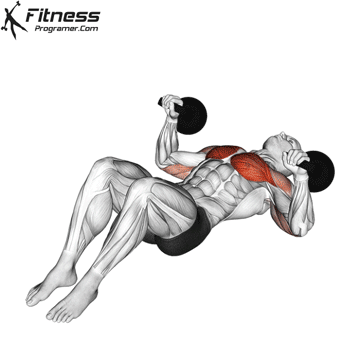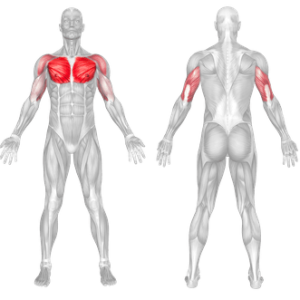Overview
The kettlebell chest press is a pressing exercise performed while lying on the ground. Unlike a traditional bench press, this variation limits the range of motion to protect the shoulders, making it an excellent choice for individuals with shoulder mobility concerns.
How to Perform

Step-by-Step Guide
Setup:
- Lie flat on your back with your knees bent and feet planted firmly on the floor.
- Hold a kettlebell in each hand with a neutral grip (palms facing each other).
Positioning:
- Keep your elbows bent at about a 45-degree angle from your torso.
- Ensure your upper arms are resting on the floor, and your wrists are aligned with your elbows.
Pressing Phase:
- Press the kettlebells upward until your arms are fully extended.
- Keep the movement controlled and avoid locking out your elbows.
Lowering Phase:
- Slowly lower the kettlebells back down until your upper arms touch the floor.
- Maintain tension in your chest and triceps throughout the movement.
Repeat:
- Perform the desired number of repetitions while maintaining proper form.
Tips for Proper Form
- Keep your core engaged to stabilize your body and prevent arching your lower back.
- Use a controlled tempo to maximize muscle engagement and prevent momentum-based lifting.
- Avoid flaring your elbows too wide, which can strain the shoulders.
- Focus on squeezing your chest and triceps at the top of the movement.
- Choose an appropriate kettlebell weight that allows you to maintain proper form.
Common Mistakes to Avoid
- Flaring the Elbows Too Wide: This puts unnecessary strain on the shoulders and reduces effectiveness.
- Lifting Too Heavy Too Soon: Using a weight that is too heavy can compromise form and increase injury risk.
- Lack of Control: Lowering the kettlebell too quickly reduces muscle engagement and can cause instability.
- Not Engaging the Core: A weak core can lead to lower back strain and improper body positioning.
- Arching the Lower Back: Maintain a neutral spine to prevent injury and maximize strength gains.
Benefits of the Kettlebell Chest Press on the Floor
1. Builds Upper Body Strength
This exercise effectively targets the chest, triceps, and shoulders, helping develop pressing strength.
2. Enhances Shoulder Stability
The kettlebell’s unique shape requires greater stabilization, improving shoulder control and joint health.
3. Reduces Shoulder Strain
Performing the press on the floor prevents the elbows from extending too far, which can reduce stress on the shoulders.
4. Improves Core Engagement
Pressing from the floor requires core activation to maintain a stable position, enhancing core strength and stability.
5. Functional Strength Development
Kettlebell training improves grip strength, coordination, and overall functional fitness, making it useful for athletes and everyday movement.
How to Incorporate Into Your Routine
- Strength Training: Perform 3-4 sets of 6-12 reps with moderate to heavy kettlebells.
- Hypertrophy (Muscle Growth): Use moderate weight with higher reps (8-15) for muscle-building benefits.
- Superset Training: Pair with a kettlebell row or push-up variation for balanced upper-body development.
- Progressive Overload: Gradually increase weight or reps over time to continue building strength.
Muscles Worked

